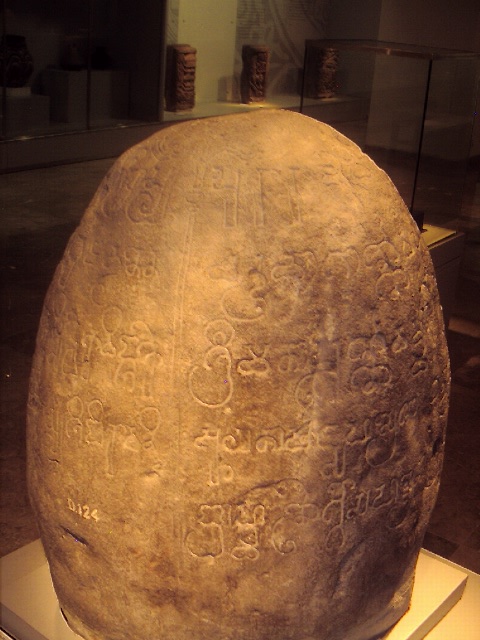|
Kebon Kopi I Inscription
Kebon Kopi I also known as Tapak Gajah inscription (elephant footprint inscription), is one of several inscriptions dated from the era of Tarumanagara Kingdom circa 5th century. The inscription bearing the image of elephant footprint, which was copied from the elephant ride of King Purnawarman of Tarumanagara, which is equated with Airavata, the elephant vahana (vehicle) of Indra. The inscription was discovered in Kebon Kopi village, Bogor, near Kebon Kopi II inscription, and named as such to differ it from this later inscription dated from Sunda Kingdom era. Content This inscription is written with Pallawa script in Sanskrit which are arranged into the form of the Anustubh metrum Shloka, which is flanked by a pair of carved images of the elephant's foot. Transcription: ''~ ~ jayavisalasya Tarumendrasya hastinah ~ ~'' ''Airwavatabhasya vibhatidam ~ padadvayam'' Translation: "Behold, here it looks like a pair of feet ...like Airavata, the elephant ride of the great Taruma ... [...More Info...] [...Related Items...] OR: [Wikipedia] [Google] [Baidu] |
Ciaruteun Inscription
Ciaruteun inscription ( id, Prasasti Ciaruteun) also written Ciarutön or also known as Ciampea inscription is a 5th-century stone inscription discovered on the riverbed of Ciaruteun River, a tributary of Cisadane River, not far from Bogor, West Java, Indonesia. The inscription is dated from the Tarumanagara kingdom period, one of the earliest Hindu kingdoms in Indonesian history. The inscription states King Purnawarman is the ruler of Tarumanagara. Location and description Ciaruteun inscription is located in Ciaruteun Ilir village, Cibungbulang district, Bogor Regency; on coordinate 6°31’23,6” Latitude dan 106°41’28,2” Longitude. This location is approximately 19 kilometres Northwest of Bogor city center. The location is a small hill (Sunda: ''pasir'') which is the confluence of three rivers: Cisadane, Cianten, and Ciaruteun. Until 19th century, the location is reported as part of Pasir Muara, which included into the private land of Tjampéa (Ciampea), although today it ... [...More Info...] [...Related Items...] OR: [Wikipedia] [Google] [Baidu] |
Tugu Inscription
The Tugu inscription is one of the early 5th century Tarumanagara inscriptions discovered in Batutumbuh hamlet, Tugu village, Koja, North Jakarta, in Indonesia. The inscription contains information about hydraulic projects; the irrigation and water drainage project of the Chandrabhaga river by the order of Rajadirajaguru, and also the water project of the Gomati river by the order of King Purnawarman in the 22nd year of his reign. The digging project to straighten and widen the river was conducted in order to avoid flooding in the wet season, and as an irrigation project during the dry season. In 1911 by the initiative of P. de Roo de la Faille, the Tugu inscription was moved to Museum Bataviaasch genootschap van Kunsten en Wetenschappen (now National Museum of Indonesia) with inventory number D.124. The inscription was carved on a round egg-like stone measuring about 1 metre. Content The Tugu inscription was written in Pallava script, arranged in the form of Sanskrit Sloka ... [...More Info...] [...Related Items...] OR: [Wikipedia] [Google] [Baidu] |
Tarumanagara Kingdom
Tarumanagara or Taruma Kingdom or just Taruma is an early Sundanese Indianised kingdom, located in western Java, whose 5th-century ruler, Purnawarman, produced the earliest known inscriptions in Java, which are estimated to date from around 450 CE. At least seven stone inscriptions connected to this kingdom were discovered in Western Java area, near Bogor and Jakarta. They are Ciaruteun, Kebon Kopi, Jambu, Pasir Awi, and Muara Cianten inscriptions near Bogor; Tugu inscription near Cilincing in North Jakarta; and Cidanghiang inscription in Lebak village, Munjul district, south of Banten. Location The inscriptions of Taruma kingdom are the earliest records of Hinduism in the western part of the archipelago. The geographical position of coastal West Java, which corresponds to today modern Jakarta, is a commanding region that controls the Sunda Strait. This location is strategic in regard to Sumatra, and also its connection to Asian continent of India and China. The kingdom ... [...More Info...] [...Related Items...] OR: [Wikipedia] [Google] [Baidu] |
Shloka
Shloka or śloka ( sa, श्लोक , from the root , Macdonell, Arthur A., ''A Sanskrit Grammar for Students'', Appendix II, p. 232 (Oxford University Press, 3rd edition, 1927). in a broader sense, according to Monier-Williams's dictionary, is "any verse or stanza; a proverb, saying"; but in particular it refers to the 32-line verse, derived from the Vedic ''anuṣṭubh'' metre, used in the ''Bhagavad Gita'' and many other works of classical Sanskrit literature. In its usual form it consists of four ''pādas'' or quarter-verses, of 8 syllables each, or (according to an alternative analysis) of two half-verses of 16 syllables each. The metre is similar to the Vedic ''anuṣṭubh'' metre, but with stricter rules. The ''śloka'' is the basis for Indian epic poetry, and may be considered the Indian verse form ''par excellence'', occurring as it does far more frequently than any other metre in classical Sanskrit poetry. The ''śloka'' is the verse-form generally used in the ''Maha ... [...More Info...] [...Related Items...] OR: [Wikipedia] [Google] [Baidu] |
Sanskrit
Sanskrit (; attributively , ; nominally , , ) is a classical language belonging to the Indo-Aryan branch of the Indo-European languages. It arose in South Asia after its predecessor languages had diffused there from the northwest in the late Bronze Age. Sanskrit is the sacred language of Hinduism, the language of classical Hindu philosophy, and of historical texts of Buddhism and Jainism. It was a link language in ancient and medieval South Asia, and upon transmission of Hindu and Buddhist culture to Southeast Asia, East Asia and Central Asia in the early medieval era, it became a language of religion and high culture, and of the political elites in some of these regions. As a result, Sanskrit had a lasting impact on the languages of South Asia, Southeast Asia and East Asia, especially in their formal and learned vocabularies. Sanskrit generally connotes several Old Indo-Aryan language varieties. The most archaic of these is the Vedic Sanskrit found in the Rig Veda, a colle ... [...More Info...] [...Related Items...] OR: [Wikipedia] [Google] [Baidu] |
Pallawa Script
The Pallava script or Pallava Grantha, is a Brahmic script, named after the Pallava dynasty of South India, attested since the 4th century AD. As epigrapher Arlo Griffiths makes clear, however, the term is misleading as not all of the relevant scripts referred to have a connection with the Pallava dynasty. He instead advocates that these scripts be called 'late Southern Brāhmī' scripts. In India, Pallava script evolved into the Tamil and Grantha script. Pallava spread to Southeast Asia and evolved into local scripts such as Balinese, Baybayin, Javanese, Kawi, Khmer, Lanna, Lao, Mon–Burmese, New Tai Lue alphabet, Sundanese, and the Thai A proposal to encode the script in Unicode was submitted in 2018. History During the rule of Pallavas, the script accompanied priests, monks, scholars and traders into Southeast Asia. Pallavas developed the Pallava script based on the Tamil-Brahmi Tamil-Brahmi, also known as Tamizhi or Damili, was a variant of the Brahmi script in ... [...More Info...] [...Related Items...] OR: [Wikipedia] [Google] [Baidu] |
Sunda Kingdom
The Sunda Kingdom ( su, , Karajaan Sunda, ) was a Sundanese Hindu kingdom located in the western portion of the island of Java from 669 to around 1579, covering the area of present-day Banten, Jakarta, West Java, and the western part of Central Java. The capital of the Sunda Kingdom moved several times during its history, shifting between the Galuh (Kawali) area in the east and Pakuan Pajajaran in the west. The Sunda Kingdom reached its peak during the reign of King Sri Baduga Maharaja, whose reign from 1482 to 1521 is traditionally remembered as an age of peace and prosperity among Sundanese people. According to primary historical records such as the Bujangga Manik manuscript, the eastern border of the kingdom was the Pamali River (Ci Pamali, the present-day Brebes River) and the Serayu River (Ci Sarayu) in Central Java. Most accounts of the Sunda Kingdom come from primary historical records from the 16th century. The kingdom's inhabitants were primarily the eponymous ethni ... [...More Info...] [...Related Items...] OR: [Wikipedia] [Google] [Baidu] |
Elephant
Elephants are the largest existing land animals. Three living species are currently recognised: the African bush elephant, the African forest elephant, and the Asian elephant. They are the only surviving members of the family Elephantidae and the order Proboscidea. The order was formerly much more diverse during the Pleistocene, but most species became extinct during the Late Pleistocene epoch. Distinctive features of elephants include a long proboscis called a trunk, tusks, large ear flaps, pillar-like legs, and tough but sensitive skin. The trunk is used for breathing, bringing food and water to the mouth, and grasping objects. Tusks, which are derived from the incisor teeth, serve both as weapons and as tools for moving objects and digging. The large ear flaps assist in maintaining a constant body temperature as well as in communication. African elephants have larger ears and concave backs, whereas Asian elephants have smaller ears, and convex or level backs. Elephants ... [...More Info...] [...Related Items...] OR: [Wikipedia] [Google] [Baidu] |
Kebon Kopi II Inscription
Kebonkopi II inscription or Pasir Muara inscription or Rakryan Juru Pangambat inscription is the oldest inscription that mentioned the toponymy ''Sunda'' dated from 854 Saka (932 CE), discovered in Kebon Kopi village, Bogor, near Kebon Kopi I inscription, and named as such to differ it from this older inscription dated from Tarumanagara era. Archaeologist F. D. K. Bosch, that had studied the inscription, wrote that this inscription was written in Old Malay, stated that a "King of Sunda has been reinstalled on the throne" and interpreting this event took place in the year 932 CE.Guillot, Claude, Lukman Nurhakim, Sonny Wibisono, (1995), ''La principauté de Banten Girang'', Archipel, Vol. 50, pp 13-24 Unfortunately this inscription was lost, stolen during the tumult of early World War II around the 1940s. Location Kebonkopi II inscription was discovered in Pasir Muara hamlet, Ciaruteun Ilir village, Cibungbulang, Bogor Regency, West Java, in the 19th century during the forest cle ... [...More Info...] [...Related Items...] OR: [Wikipedia] [Google] [Baidu] |





_colourised.png)
